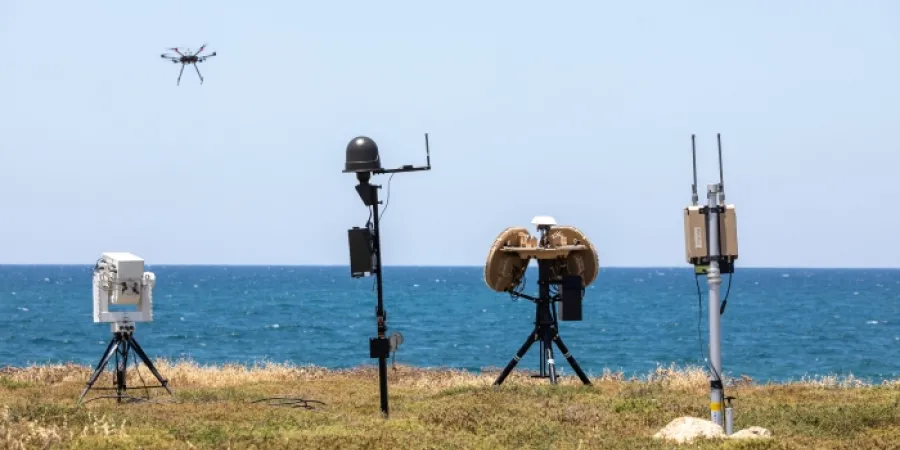Britain deployed Rafael’s Drone Dome to defend G7 Summit from UAV threats
The meeting of the world's advanced economies is said to have been one of the many times that the British Defence Ministry used the Israeli company's combat-proven counter-UAV system since acquiring several of them three years ago
IsraelDefense
|
13/09/2021
Israel's Rafael Advanced Defense Systems revealed on Monday that the British Ministry of Defence employed Rafael’s Drone Dome counter-UAV system in June to protect world leaders from potential threats during the G7 Summit in Cornwall, England.
The Defence Ministry purchased several Drone Dome systems three years ago, and has successfully employed them in a multitude of operational scenarios, including for protecting both the physical site and participants of this year’s G7 summit, Rafael said.
Drone Dome is an end-to-end, combat-proven counter-Unmanned Aerial System (C-UAS), providing all-weather, 360-degree rapid defense against hostile drones. Fully operational and globally deployed, Drone Dome offers a modular, robust infrastructure comprised of electronic jammers and sensors and unique artificial intelligence algorithms to effectively secure threatened airspace, according to the company.
The system's advanced technology allows it to effectively address threats through detection, identification, and neutralization. When Drone Dome identifies a threat, it locks onto the target, tracks it, and carries out either a soft or hard-kill with its unique, integrated laser technology. This laser system operates reliably in any weather condition, and results in minimal environmental damage, Rafael said.
In addition, Drone Dome's artificial intelligence capabilities, along with the advanced laser and sensor systems, provide a more precise picture of the incoming threat, allowing the system to both detect and identify specific threat elements more accurately and engage and neutralize the target faster and more efficiently. The system's flexibility across military and civil applications offers advanced protection for maneuvering forces, sensitive facilities, border protection, as well as increasingly vulnerable civilian targets like airports and other public facilities, according to Rafael.
Meir Ben Shaya, Rafael EVP for Marketing and Business Development of Air Defence Systems, said "Rafael today recognizes two new and key trends in the field of counter-UAVs, both of which Drone Dome can successfully defend against."
"The first trend is the number of drones employed during an attack, and the operational need to have the ability to counter multiple, simultaneous attacks; this is a significant, practical challenge that any successful system must be able to overcome. The second trend is the type of tool being employed. Previously, air defense systems were developed to seek out conventional aircraft, large unmanned aerial vehicles, and missiles, but today these defense systems must also tackle smaller, slower, low-flying threats which are becoming more and more autonomous. Today’s threats pose a significant challenge for SIGNT and radar systems which are predominantly built to seek larger, more conventional targets. These new threats require hard-kill solutions, which is precisely why Rafael developed its laser interception system now integrated into Drone Dome."
The meeting of the world's advanced economies is said to have been one of the many times that the British Defence Ministry used the Israeli company's combat-proven counter-UAV system since acquiring several of them three years ago
Israel's Rafael Advanced Defense Systems revealed on Monday that the British Ministry of Defence employed Rafael’s Drone Dome counter-UAV system in June to protect world leaders from potential threats during the G7 Summit in Cornwall, England.
The Defence Ministry purchased several Drone Dome systems three years ago, and has successfully employed them in a multitude of operational scenarios, including for protecting both the physical site and participants of this year’s G7 summit, Rafael said.
Drone Dome is an end-to-end, combat-proven counter-Unmanned Aerial System (C-UAS), providing all-weather, 360-degree rapid defense against hostile drones. Fully operational and globally deployed, Drone Dome offers a modular, robust infrastructure comprised of electronic jammers and sensors and unique artificial intelligence algorithms to effectively secure threatened airspace, according to the company.
The system's advanced technology allows it to effectively address threats through detection, identification, and neutralization. When Drone Dome identifies a threat, it locks onto the target, tracks it, and carries out either a soft or hard-kill with its unique, integrated laser technology. This laser system operates reliably in any weather condition, and results in minimal environmental damage, Rafael said.
In addition, Drone Dome's artificial intelligence capabilities, along with the advanced laser and sensor systems, provide a more precise picture of the incoming threat, allowing the system to both detect and identify specific threat elements more accurately and engage and neutralize the target faster and more efficiently. The system's flexibility across military and civil applications offers advanced protection for maneuvering forces, sensitive facilities, border protection, as well as increasingly vulnerable civilian targets like airports and other public facilities, according to Rafael.
Meir Ben Shaya, Rafael EVP for Marketing and Business Development of Air Defence Systems, said "Rafael today recognizes two new and key trends in the field of counter-UAVs, both of which Drone Dome can successfully defend against."
"The first trend is the number of drones employed during an attack, and the operational need to have the ability to counter multiple, simultaneous attacks; this is a significant, practical challenge that any successful system must be able to overcome. The second trend is the type of tool being employed. Previously, air defense systems were developed to seek out conventional aircraft, large unmanned aerial vehicles, and missiles, but today these defense systems must also tackle smaller, slower, low-flying threats which are becoming more and more autonomous. Today’s threats pose a significant challenge for SIGNT and radar systems which are predominantly built to seek larger, more conventional targets. These new threats require hard-kill solutions, which is precisely why Rafael developed its laser interception system now integrated into Drone Dome."



